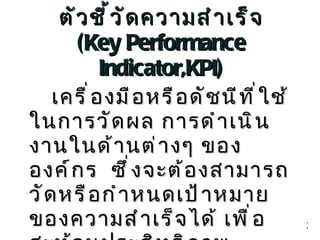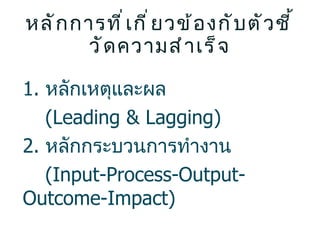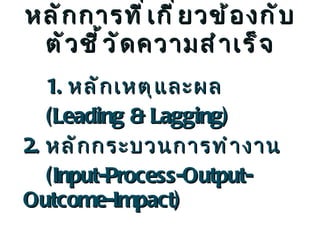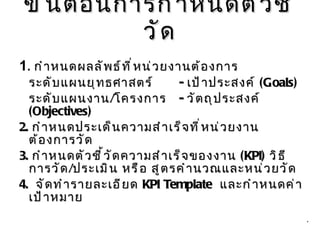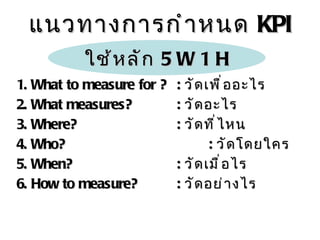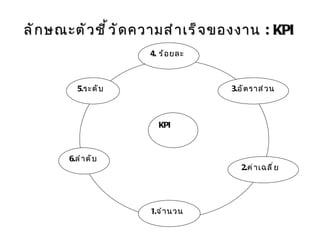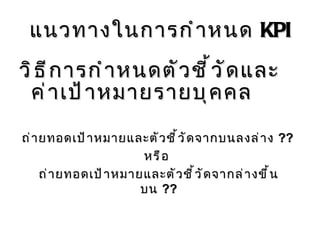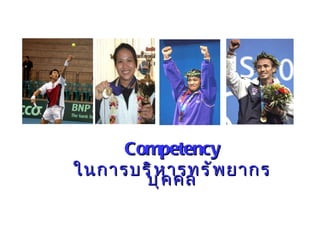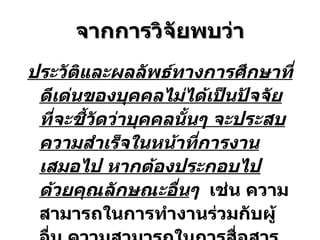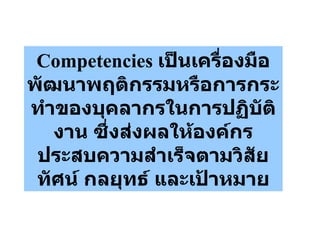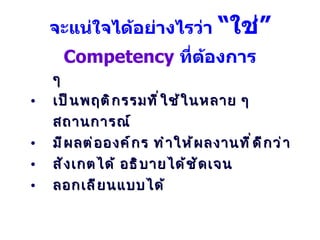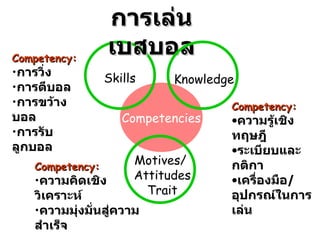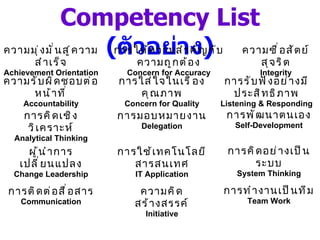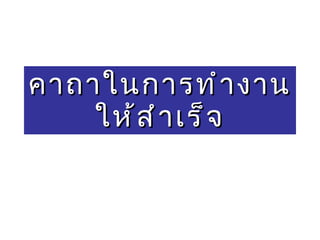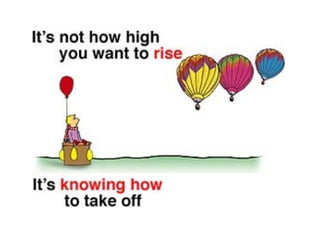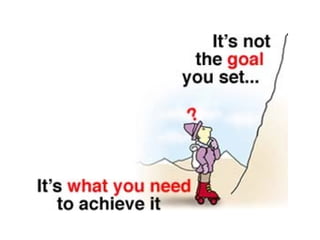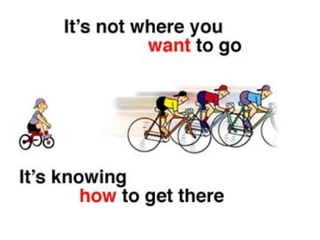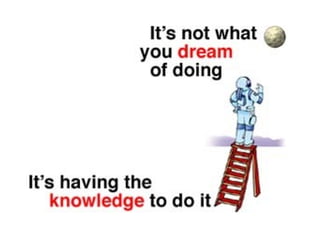Kpi 18 1_55
- 1. Á¡Á¡ÝÁ¡ÏÁ¡Á¡çÁ¿Á¡ÏÁ¡ÝÁ¡ / Á¡ˆÁ¡ÀÁ¡ÈÁ¡ÈÁ¡Á¡Á¡¯Á¿Á¡Á¡Á¡ýÁ¡ÈÁ¡Á¡ÈÁ¡¯Á¿Á¡ÀÁ¡ÇÁ¡Á¡Á¡ýÁ¡ÈÁ¡Á¡Á¡ÇÁ¡Á¡ÝÁ¡Á¡ÇÁ¡ÈÁ¡ýÁ¡Á¡Á¡ýÁ¡ÈÁ¡Á¡ÙÁ¡Á¡Á¡¡Á¡Á¡ËÁ¡ýÁ¡Á¡È Á¡ÈÁ¡ÙÁ¡Á¡´Á¡ýÁ¡ˆÁ¡Á¡ÈÁ¡ýÁ¡Á¡ýÁ¡ÈÁ¡ÂÁ¿Á¡ÈÁ¡¯Á¡Á¡çÁ¡Á¡ÈÁ¡ÈÁ¡ Á¡Á¡ËÁ¡ÙÁ¡Á¡ˆÁ¡¡Á¡ Á¡ÏÁ¡ÝÁ¡Á¡Á¡çÁ¿ Á¿Á¿ Á¡ÀÁ¡Á¡ÈÁ¡ýÁ¡Á¡À Á¡ . Á¡´ . Á¿Á¿Á¿Á¿
- 3. Á¡Á¡ÝÁ¡ÏÁ¡Á¡çÁ¿Á¡ÏÁ¡ÝÁ¡Á¡Á¡ÏÁ¡ýÁ¡ÀÁ¡ˆÁ¡°Á¿Á¡ÈÁ¿Á¡ (Key Performance Indicator,KPI) Á¿Á¡Á¡ÈÁ¡ñÁ¿Á¡ÙÁ¡Á¡ÀÁ¡ñÁ¡ÙÁ¡¨Á¡ÈÁ¡ñÁ¡ÙÁ¡Á¡ÝÁ¡Á¡Á¡çÁ¡Á¡çÁ¿Á¿Á¡Á¿Á¿Á¡Á¡Á¡ýÁ¡ÈÁ¡ÏÁ¡ÝÁ¡Á¡Á¡Ë Á¡Á¡ýÁ¡ÈÁ¡Á¡°Á¿Á¡Á¡ÇÁ¡Á¡Á¡ýÁ¡Á¿Á¡Á¡Á¿Á¡ýÁ¡Á¡Á¿Á¡ýÁ¡Á¿ Á¡Á¡ÙÁ¡Á¡ÙÁ¡Á¡Á¿Á¡Á¡È Á¡Á¡ÑÁ¿Á¡Á¡Á¡¯Á¡Á¿Á¡ÙÁ¡Á¡ˆÁ¡ýÁ¡ÀÁ¡ýÁ¡ÈÁ¡Á¡ÏÁ¡ÝÁ¡Á¡¨Á¡ÈÁ¡ñÁ¡ÙÁ¡Á¡°Á¡¨Á¡Á¡Á¿Á¡Á¿Á¡ýÁ¡¨Á¡ÀÁ¡ýÁ¡ÂÁ¡Á¡ÙÁ¡Á¡Á¡ÏÁ¡ýÁ¡ÀÁ¡ˆÁ¡°Á¿Á¡ÈÁ¿Á¡Á¿Á¡Á¿ Á¿Á¡Á¡ñÁ¿Á¡ÙÁ¡ˆÁ¡¯Á¡Á¿Á¡ÙÁ¡Á¡Á¡ÈÁ¡¯Á¡ˆÁ¡ÇÁ¡Á¡Á¡ÇÁ¡ Á¡ýÁ¡ Á¡Á¡ÈÁ¡¯Á¡ˆÁ¡ÇÁ¡Á¡Á¡ÇÁ¡Á¡ËÁ¡Á¡ýÁ¡ÈÁ¡Á¡°Á¡Á¡ýÁ¡Á¡Á¡ÙÁ¡Á¡ÙÁ¡Á¡Á¿Á¡Á¡È 3
- 4. Á¡¨Á¡ËÁ¡ÝÁ¡Á¡Á¡ýÁ¡ÈÁ¡Á¡çÁ¿Á¿Á¡Á¡çÁ¿Á¡ÂÁ¡ÏÁ¡Á¿Á¡ÙÁ¡Á¡Á¡ÝÁ¡Á¡Á¡ÝÁ¡ÏÁ¡Á¡çÁ¿Á¡ÏÁ¡ÝÁ¡Á¡Á¡ÏÁ¡ýÁ¡ÀÁ¡ˆÁ¡°Á¿Á¡ÈÁ¿Á¡ 1. Á¡¨Á¡ËÁ¡ÝÁ¡Á¿Á¡¨Á¡Á¡¡Á¿Á¡ËÁ¡¯Á¡Á¡Ë (Leading & Lagging) 2. Á¡¨Á¡ËÁ¡ÝÁ¡Á¡Á¡ÈÁ¡¯Á¡Á¡ÏÁ¡Á¡Á¡ýÁ¡ÈÁ¡Á¡°Á¡Á¡ýÁ¡ (Input-Process-Output-Outcome-Impact)
- 5. Á¡¨Á¡ËÁ¡ÝÁ¡Á¡Á¡ýÁ¡ÈÁ¡Á¡çÁ¿Á¿Á¡Á¡çÁ¿Á¡ÂÁ¡ÏÁ¡Á¿Á¡ÙÁ¡Á¡Á¡ÝÁ¡Á¡Á¡ÝÁ¡ÏÁ¡Á¡çÁ¿Á¡ÏÁ¡ÝÁ¡Á¡Á¡ÏÁ¡ýÁ¡ÀÁ¡ˆÁ¡°Á¿Á¡ÈÁ¿Á¡ 1. Á¡¨Á¡ËÁ¡ÝÁ¡Á¿Á¡¨Á¡Á¡¡Á¿Á¡ËÁ¡¯Á¡Á¡Ë (Leading & Lagging) 2. Á¡¨Á¡ËÁ¡ÝÁ¡Á¡Á¡ÈÁ¡¯Á¡Á¡ÏÁ¡Á¡Á¡ýÁ¡ÈÁ¡Á¡°Á¡Á¡ýÁ¡ (Input-Process-Output-Outcome-Impact)
- 6. Á¡Á¡ÝÁ¿Á¡Á¡Á¡ÙÁ¡Á¡Á¡ýÁ¡ÈÁ¡Á¡°Á¡¨Á¡Á¡Á¡Á¡ÝÁ¡ÏÁ¡Á¡çÁ¿Á¡ÏÁ¡ÝÁ¡ 1 . Á¡Á¡°Á¡¨Á¡Á¡Á¡Á¡ËÁ¡ËÁ¡ÝÁ¡Á¡Á¿Á¡Á¡çÁ¿Á¡¨Á¡Á¿Á¡ÏÁ¡ÂÁ¡Á¡ýÁ¡Á¡Á¿Á¡ÙÁ¡Á¡Á¡ýÁ¡È Á¡ÈÁ¡¯Á¡Á¡ÝÁ¡Á¿Á¡Á¡Á¡ÂÁ¡¡Á¡Á¡Á¡´Á¡ýÁ¡ˆÁ¡Á¡ÈÁ¿ - Á¿Á¡Á¿Á¡ýÁ¡Á¡ÈÁ¡¯Á¡ˆÁ¡Á¡Á¿ (Goals) Á¡ÈÁ¡¯Á¡Á¡ÝÁ¡Á¿Á¡Á¡Á¡Á¡ýÁ¡ / Á¿Á¡Á¡ÈÁ¡Á¡Á¡ýÁ¡È - Á¡ÏÁ¡ÝÁ¡Á¡Á¡¡Á¡Á¡ÈÁ¡¯Á¡ˆÁ¡Á¡Á¿ (Objectives) 2. Á¡Á¡°Á¡¨Á¡Á¡Á¡Á¡ÈÁ¡¯Á¿Á¡Á¿Á¡Á¡Á¡ÏÁ¡ýÁ¡ÀÁ¡ˆÁ¡°Á¿Á¡ÈÁ¿Á¡Á¡Á¡çÁ¿Á¡¨Á¡Á¿Á¡ÏÁ¡ÂÁ¡Á¡ýÁ¡Á¡Á¿Á¡ÙÁ¡Á¡Á¡ýÁ¡ÈÁ¡ÏÁ¡ÝÁ¡ 3. Á¡Á¡°Á¡¨Á¡Á¡Á¡Á¡ÝÁ¡ÏÁ¡Á¡çÁ¿Á¡ÏÁ¡ÝÁ¡Á¡Á¡ÏÁ¡ýÁ¡ÀÁ¡ˆÁ¡°Á¿Á¡ÈÁ¿Á¡Á¡Á¡ÙÁ¡Á¡Á¡ýÁ¡ (KPI) Á¡ÏÁ¡ÇÁ¡Á¡çÁ¡Á¡ýÁ¡ÈÁ¡ÏÁ¡ÝÁ¡ / Á¡Á¡ÈÁ¡¯Á¿Á¡ÀÁ¡ÇÁ¡ Á¡¨Á¡ÈÁ¡ñÁ¡Ù Á¡ˆÁ¡¿Á¡Á¡ÈÁ¡Á¡°Á¡Á¡ÏÁ¡Á¿Á¡ËÁ¡¯Á¡¨Á¡Á¿Á¡ÏÁ¡ÂÁ¡ÏÁ¡ÝÁ¡ 4. Á¡Á¡ÝÁ¡Á¡Á¡°Á¡ÈÁ¡ýÁ¡ÂÁ¡ËÁ¡¯Á¿Á¡ÙÁ¡çÁ¡ÂÁ¡ KPI Template Á¿Á¡ËÁ¡¯Á¡Á¡°Á¡¨Á¡Á¡Á¡Á¿Á¡ýÁ¿Á¡Á¿Á¡ýÁ¡¨Á¡ÀÁ¡ýÁ¡Â 7
- 7. Á¿Á¡Á¡ÏÁ¡Á¡ýÁ¡Á¡Á¡ýÁ¡ÈÁ¡Á¡°Á¡¨Á¡Á¡ KPI 1. What to measure for ? : Á¡ÏÁ¡ÝÁ¡Á¿Á¡Á¡ñÁ¿Á¡ÙÁ¡ÙÁ¡¯Á¿Á¡È 2. What measures? : Á¡ÏÁ¡ÝÁ¡Á¡ÙÁ¡¯Á¿Á¡È 3. Where? : Á¡ÏÁ¡ÝÁ¡Á¡Á¡çÁ¿Á¿Á¡¨Á¡ 4. Who? : Á¡ÏÁ¡ÝÁ¡Á¿Á¡Á¡ÂÁ¿Á¡Á¡È 5. When? : Á¡ÏÁ¡ÝÁ¡Á¿Á¡ÀÁ¡ñÁ¿Á¡ÙÁ¿Á¡È 6. How to measure? : Á¡ÏÁ¡ÝÁ¡Á¡ÙÁ¡ÂÁ¿Á¡ýÁ¡Á¿Á¡È Á¿Á¡Á¿Á¡¨Á¡ËÁ¡ÝÁ¡ 5 W 1 H
- 8. Á¡ËÁ¡ÝÁ¡Á¡ˋÁ¡Á¡¯Á¡Á¡ÝÁ¡ÏÁ¡Á¡çÁ¿Á¡ÏÁ¡ÝÁ¡Á¡Á¡ÏÁ¡ýÁ¡ÀÁ¡ˆÁ¡°Á¿Á¡ÈÁ¿Á¡Á¡Á¡ÙÁ¡Á¡Á¡ýÁ¡ : KPI KPI 4. Á¡ÈÁ¿Á¡ÙÁ¡ÂÁ¡ËÁ¡¯ 3. Á¡ÙÁ¡ÝÁ¡Á¡ÈÁ¡ýÁ¡ˆÁ¿Á¡ÏÁ¡ 2. Á¡Á¿Á¡ýÁ¿Á¡Á¡ËÁ¡çÁ¿Á¡Â 1. Á¡Á¡°Á¡Á¡ÏÁ¡ 6. Á¡ËÁ¡°Á¡Á¡ÝÁ¡ 5. Á¡ÈÁ¡¯Á¡Á¡ÝÁ¡
- 9. Á¿Á¡Á¡ÏÁ¡Á¡ýÁ¡Á¿Á¡Á¡Á¡ýÁ¡ÈÁ¡Á¡°Á¡¨Á¡Á¡ KPI Á¡ÏÁ¡ÇÁ¡Á¡çÁ¡Á¡ýÁ¡ÈÁ¡Á¡°Á¡¨Á¡Á¡Á¡Á¡ÝÁ¡ÏÁ¡Á¡çÁ¿Á¡ÏÁ¡ÝÁ¡Á¿Á¡ËÁ¡¯Á¡Á¿Á¡ýÁ¿Á¡Á¿Á¡ýÁ¡¨Á¡ÀÁ¡ýÁ¡ÂÁ¡ÈÁ¡ýÁ¡ÂÁ¡Á¡¡Á¡Á¡Á¡Ë Á¡Á¿Á¡ýÁ¡ÂÁ¡Á¡ÙÁ¡Á¿Á¡Á¿Á¡ýÁ¡¨Á¡ÀÁ¡ýÁ¡ÂÁ¿Á¡ËÁ¡¯Á¡Á¡ÝÁ¡ÏÁ¡Á¡çÁ¿Á¡ÏÁ¡ÝÁ¡Á¡Á¡ýÁ¡Á¡Á¡Á¡ËÁ¡Á¡ËÁ¿Á¡ýÁ¡ ?? Á¡¨Á¡ÈÁ¡ñÁ¡Ù Á¡Á¿Á¡ýÁ¡ÂÁ¡Á¡ÙÁ¡Á¿Á¡Á¿Á¡ýÁ¡¨Á¡ÀÁ¡ýÁ¡ÂÁ¿Á¡ËÁ¡¯Á¡Á¡ÝÁ¡ÏÁ¡Á¡çÁ¿Á¡ÏÁ¡ÝÁ¡Á¡Á¡ýÁ¡Á¡ËÁ¿Á¡ýÁ¡Á¡Á¡ÑÁ¿Á¡Á¡Á¡ ??
- 11. Competency( Á¡ˆÁ¡ÀÁ¡ÈÁ¡ÈÁ¡Á¡Á¡¯ ) Á¡Á¡ñÁ¡ÙÁ¡ÙÁ¡¯Á¿Á¡È Competency Á¡¨Á¡ÀÁ¡ýÁ¡ÂÁ¡Á¡ÑÁ¡ Á¡Á¡ËÁ¡¡Á¿Á¡ÀÁ¡Á¡ÙÁ¡Á¡Á¡ÝÁ¡Á¡ˋÁ¡¯ Á¡Á¡ÏÁ¡ýÁ¡ÀÁ¡ÈÁ¡¿Á¿ Á¡Á¡ÏÁ¡ýÁ¡ÀÁ¡ˆÁ¡ýÁ¡ÀÁ¡ýÁ¡ÈÁ¡ Á¡ÈÁ¡ÏÁ¡ÀÁ¡Á¡ÝÁ¿Á¡ Á¡Á¡ÊÁ¡Á¡ÇÁ¡Á¡ÈÁ¡ÈÁ¡À Á¡Á¡¡Á¡Á¡ËÁ¡ÝÁ¡Á¡ˋÁ¡Á¡¯Á¿Á¡ËÁ¡¯Á¡Á¡ÝÁ¡´Á¡Á¡Á¡Á¡ÇÁ¡Á¡çÁ¿Á¡Á¡¡Á¡Á¡ËÁ¡ýÁ¡Á¡ÈÁ¡Á¡°Á¿Á¡Á¿Á¡Á¡Á¿Á¡ÙÁ¡Á¡ÀÁ¡çÁ¿Á¡Á¡ñÁ¿Á¡ÙÁ¡Á¡Á¡ÇÁ¡Á¡ÝÁ¡Á¡ÇÁ¡Á¡ýÁ¡Á¡ÙÁ¡ÂÁ¿Á¡ýÁ¡Á¡ÀÁ¡çÁ¡Á¡ÈÁ¡¯Á¡ˆÁ¡ÇÁ¡Á¡Á¡ÇÁ¡ Á¡ýÁ¡ Á¡Á¡ÈÁ¡¯Á¡ˆÁ¡ÇÁ¡Á¡Á¡ÇÁ¡Á¡Ë Á¿Á¡ËÁ¡¯Á¿Á¡Á¡ñÁ¿Á¡ÙÁ¿Á¡¨Á¿Á¡Á¡ÈÁ¡ÈÁ¡ËÁ¡¡Á¡Á¡ËÁ¡ˆÁ¡°Á¿Á¡ÈÁ¿Á¡Á¡Á¡ÈÁ¡Á¡Á¡ýÁ¡ÀÁ¡ÏÁ¡ÝÁ¡Á¡Á¡¡Á¡Á¡ÈÁ¡¯Á¡ˆÁ¡Á¡Á¿Á¿Á¡ËÁ¡¯Á¿Á¡Á¿Á¡ýÁ¡¨Á¡ÀÁ¡ýÁ¡ÂÁ¡Á¡ÙÁ¡Á¡ÙÁ¡Á¡Á¿Á¡Á¡È
- 12. Á¡Á¡ýÁ¡Á¡Á¡ýÁ¡ÈÁ¡ÏÁ¡ÇÁ¡Á¡ÝÁ¡ÂÁ¡Á¡Á¡ÏÁ¿Á¡ý Á¡Á¡ÈÁ¡¯Á¡ÏÁ¡ÝÁ¡Á¡ÇÁ¿Á¡ËÁ¡¯Á¡Á¡ËÁ¡ËÁ¡ÝÁ¡Á¡Á¿Á¡Á¡ýÁ¡Á¡Á¡ýÁ¡ÈÁ¡´Á¡ÑÁ¡Á¡ˋÁ¡ýÁ¡Á¡çÁ¿Á¡Á¡çÁ¿Á¡Á¿Á¡Á¡Á¡ÙÁ¡Á¡Á¡¡Á¡Á¡Á¡ËÁ¿Á¡ÀÁ¿Á¿Á¡Á¿Á¿Á¡Á¿Á¡Á¡Á¡ÝÁ¡Á¡Á¡ÝÁ¡ÂÁ¡Á¡çÁ¿Á¡Á¡¯Á¡Á¡çÁ¿Á¡ÏÁ¡ÝÁ¡Á¡ÏÁ¿Á¡ýÁ¡Á¡¡Á¡Á¡Á¡ËÁ¡Á¡ÝÁ¿Á¡Á¿ Á¡Á¡¯Á¡Á¡ÈÁ¡¯Á¡ˆÁ¡Á¡Á¡ÏÁ¡ýÁ¡ÀÁ¡ˆÁ¡°Á¿Á¡ÈÁ¿Á¡Á¿Á¡Á¡¨Á¡Á¿Á¡ýÁ¡Á¡çÁ¿Á¡Á¡ýÁ¡ÈÁ¡Á¡ýÁ¡Á¿Á¡ˆÁ¡ÀÁ¡ÙÁ¿Á¡ Á¡¨Á¡ýÁ¡ Á¡Á¿Á¡ÙÁ¡Á¡Á¡ÈÁ¡¯Á¡Á¡Ù Á¡ Á¿Á¡Á¡Á¿Á¡ÏÁ¡ÂÁ¡Á¡¡Á¡Á¡ËÁ¡ÝÁ¡Á¡ˋÁ¡Á¡¯Á¡ÙÁ¡ñÁ¿Á¡ Á¿ Á¿Á¡Á¿Á¡ Á¡Á¡ÏÁ¡ýÁ¡ÀÁ¡ˆÁ¡ýÁ¡ÀÁ¡ýÁ¡ÈÁ¡Á¿Á¡Á¡Á¡ýÁ¡ÈÁ¡Á¡°Á¡Á¡ýÁ¡Á¡ÈÁ¿Á¡ÏÁ¡ÀÁ¡Á¡ÝÁ¡Á¡Á¡¿Á¿Á¡ÙÁ¡ñÁ¿Á¡ Á¡Á¡ÏÁ¡ýÁ¡ÀÁ¡ˆÁ¡ýÁ¡ÀÁ¡ýÁ¡ÈÁ¡Á¿Á¡Á¡Á¡ýÁ¡ÈÁ¡ˆÁ¡ñÁ¿Á¡ÙÁ¡ˆÁ¡ýÁ¡ÈÁ¿Á¡ËÁ¡¯Á¡Á¡ýÁ¡ÈÁ¡ÀÁ¡çÁ¡Á¡Á¡ÇÁ¡ˆÁ¡ÝÁ¡ÀÁ¡Á¡ÝÁ¡Á¡Á¿Á¡Á¡ÝÁ¡Á¡Á¡¿Á¿Á¡ÙÁ¡ñÁ¿Á¡ Á¿Á¡Á¿Á¡Á¡Á¿Á¡
- 13. Competencies Á¿Á¡Á¿Á¡Á¿Á¡Á¡ÈÁ¡ñÁ¿Á¡ÙÁ¡Á¡ÀÁ¡ñÁ¡ÙÁ¡Á¡ÝÁ¡Á¡Á¡ýÁ¡Á¡ÊÁ¡Á¡ÇÁ¡Á¡ÈÁ¡ÈÁ¡ÀÁ¡¨Á¡ÈÁ¡ñÁ¡ÙÁ¡Á¡ýÁ¡ÈÁ¡Á¡ÈÁ¡¯Á¡Á¡°Á¡Á¡ÙÁ¡Á¡Á¡¡Á¡Á¡ËÁ¡ýÁ¡Á¡ÈÁ¿Á¡Á¡Á¡ýÁ¡ÈÁ¡Á¡Á¡ÇÁ¡Á¡ÝÁ¡Á¡ÇÁ¡Á¡ýÁ¡ Á¡Á¡ÑÁ¿Á¡Á¡ˆÁ¿Á¡Á¡Á¡ËÁ¿Á¡¨Á¿Á¡ÙÁ¡Á¡Á¿Á¡Á¡ÈÁ¡Á¡ÈÁ¡¯Á¡ˆÁ¡Á¡Á¡ÏÁ¡ýÁ¡ÀÁ¡ˆÁ¡°Á¿Á¡ÈÁ¿Á¡Á¡Á¡ýÁ¡ÀÁ¡ÏÁ¡ÇÁ¡ˆÁ¡ÝÁ¡ÂÁ¡Á¡ÝÁ¡´Á¡Á¿ Á¡Á¡ËÁ¡ÂÁ¡¡Á¡Á¡Á¿ Á¿Á¡ËÁ¡¯Á¿Á¡Á¿Á¡ýÁ¡¨Á¡ÀÁ¡ýÁ¡Â
- 14. Á¿Á¡Á¿Á¡Á¡Á¡ÊÁ¡Á¡ÇÁ¡Á¡ÈÁ¡ÈÁ¡ÀÁ¡Á¡çÁ¿Á¡Á¿Á¡ÙÁ¡Á¿Á¡Á¡ÇÁ¡Á¡Á¡ÑÁ¿Á¡ Á¿Á¡Á¿Á¡Á¿Á¡ÙÁ¡Â Á¿ Á¿Á¡Á¿Á¡Á¡Á¡ÊÁ¡Á¡ÇÁ¡Á¡ÈÁ¡ÈÁ¡ÀÁ¡Á¡çÁ¿Á¿Á¡Á¿Á¿Á¡Á¡¨Á¡ËÁ¡ýÁ¡Â Á¿ Á¡ˆÁ¡Á¡ýÁ¡Á¡Á¡ýÁ¡ÈÁ¡Á¿ Á¡ÀÁ¡çÁ¡Á¡ËÁ¡Á¿Á¡ÙÁ¡ÙÁ¡Á¡Á¿Á¡Á¡È Á¡Á¡°Á¿Á¡¨Á¿Á¡Á¡ËÁ¡Á¡ýÁ¡Á¡Á¡çÁ¿Á¡Á¡çÁ¡Á¡ÏÁ¿Á¡ý Á¡ˆÁ¡ÝÁ¡Á¿Á¡Á¡Á¿Á¡Á¿ Á¡ÙÁ¡Á¡ÇÁ¡Á¡ýÁ¡ÂÁ¿Á¡Á¿Á¡Á¡ÝÁ¡Á¿Á¡Á¡ Á¡ËÁ¡ÙÁ¡Á¿Á¡ËÁ¡çÁ¡ÂÁ¡Á¿Á¡Á¡Á¿Á¡Á¿ Á¡Á¡¯Á¿Á¡Á¿Á¿Á¡Á¿Á¡Á¿Á¡ÙÁ¡ÂÁ¿Á¡ýÁ¡Á¿Á¡ÈÁ¡ÏÁ¿Á¡ý ãÁ¿Á¡Á¿ã Competency Á¡Á¡çÁ¿Á¡Á¿Á¡ÙÁ¡Á¡Á¡ýÁ¡È
- 15. Á¡ÀÁ¡ÙÁ¡Á¿Á¡¨Á¿Á¡Á¿Á¡Á¿Á¡Á¿Á¡ýÁ¡Â Á¡Á¡ÝÁ¡Á¡Á¡ýÁ¿Á¡Á¿Á¡Á¿Á¡ýÁ¡Â Á¡Á¡Á¡Á¡ýÁ¡Á¡Á¡ýÁ¡Á¡ˆÁ¡ÝÁ¡Á¡Á¡À Á¡Á¿Á¡ýÁ¡Á¡ÇÁ¡ÂÁ¡À Á¡ÙÁ¡¡Á¡Á¡Á¡ÇÁ¡ˆÁ¡ÝÁ¡Â Á¿Á¡ÈÁ¡Á¡Á¡¿Á¡Á¿Á¡ Á¡Á¡ÏÁ¡ýÁ¡ÀÁ¡ÈÁ¡¿Á¿ Á¡Á¡ÝÁ¡Á¡ˋÁ¡¯ Á¡ÀÁ¡ÙÁ¡Á¿Á¡¨Á¿Á¡Á¿Á¡Á¿Á¡ÂÁ¡ýÁ¡ Á¡Á¡ÝÁ¡Á¡Á¡ýÁ¡ÂÁ¡ýÁ¡ Iceberg Model of Competency Competency Á¡Á¡°Á¿Á¡Á¿Á¡Á¿Á¡Á¿Á¿Á¡ÀÁ¿Á¿Á¡Á¡çÁ¡ÂÁ¡Á¡Á¡Ù Á¡Á¡°Á¿Á¡Á¿Á¡Á¿Á¡Á¡ñÁ¿Á¡ÙÁ¿Á¡¨Á¿Á¡Á¡ÈÁ¡¯Á¡ˆÁ¡Á¡Á¡ÏÁ¡ýÁ¡ÀÁ¡ˆÁ¡°Á¿Á¡ÈÁ¿Á¡ Á¡Á¿Á¡ÙÁ¡ÀÁ¡¿Á¡ËÁ¡Á¡ÏÁ¡ýÁ¡ÀÁ¡ÈÁ¡¿Á¿Á¡Á¡çÁ¿Á¡Á¡¡Á¡Á¡Á¡ËÁ¡ÀÁ¡ç Á¿Á¡Á¡ˆÁ¡ýÁ¡Á¡ýÁ¡Á¿Á¡ýÁ¡Á¿ Á¡Á¡ÏÁ¡ýÁ¡ÀÁ¿Á¡Á¡çÁ¿Á¡ÂÁ¡ÏÁ¡Á¡ýÁ¡ Á¡Á¡°Á¡Á¡ýÁ¡Á¡Á¡ÇÁ¿Á¡´Á¡ˋÁ¿Á¡Á¡Á¿Á¡ýÁ¡Á¡Á¿Á¡ýÁ¡Á¿ Á¡Á¡Á¡Á¡ýÁ¡Á¡Á¡çÁ¿Á¡Á¡¡Á¡Á¡Á¡ËÁ¿Á¡ˆÁ¡Á¡Á¡ÙÁ¡ÙÁ¡Á¡Á¿Á¡ÙÁ¡Á¡¿Á¿Á¡ÙÁ¡ñÁ¿Á¡ Á¡Á¡ÏÁ¡ýÁ¡ÀÁ¿Á¡Á¡ÂÁ¡Á¡ÇÁ¡ Á¡Á¡ÊÁ¡Á¡ÇÁ¡Á¡ÈÁ¡ÈÁ¡ÀÁ¡Á¿Á¡°Á¿Á¿Á¡Á¡ÈÁ¡¿Á¡Á¿Á¡Á¡Á¿ Á¡ Á¡ÈÁ¡¿Á¡Á¿Á¡Á¡Á¡¨Á¡Á¡ÑÁ¿Á¡ Á¡Á¡ÏÁ¡ýÁ¡ÀÁ¡ÈÁ¡¿Á¿Á¡ˆÁ¡ÑÁ¡Á¡Á¡ÑÁ¡Á¡Á¡ÇÁ¡Á¿Á¡Á¡çÁ¿Á¡ÂÁ¡ÏÁ¡Á¡ÝÁ¡ Á¿Á¡ÙÁ¡Á¡ËÁ¡ÝÁ¡Á¡ˋÁ¡Á¿Á¿Á¡ËÁ¡¯Á¡Á¡¡Á¡Á¡Á¿Á¡ýÁ¡Á¡ÙÁ¡Á¡Á¡ Á¡Á¡ÇÁ¡Á¡Á¡Á¡ýÁ¡Á¡ýÁ¡È Á¿Á¡Á¡ÏÁ¿Á¡Á¿Á¡ÀÁ¡ÏÁ¡ÇÁ¡Á¡çÁ¡Á¡ÇÁ¡ Á¡ÏÁ¡ÇÁ¡Á¡çÁ¡Á¡Á¡ÇÁ¡Á¡ÝÁ¡Á¡ÇÁ¡Á¡Á¡ÙÁ¡ÝÁ¡Á¿Á¡Á¿Á¡Á¿Á¡Á¿Á¡Á¡ÂÁ¡Á¡ÈÁ¡ÈÁ¡ÀÁ¡Á¡ýÁ¡Á¡ÇÁ¡Á¡ÙÁ¡Á¡Á¡¡Á¡Á¡Á¡Ë
- 16. Competencies Skills Knowledge Motives/ Attitudes Trait Competency: Á¡Á¡ýÁ¡ÈÁ¡ÏÁ¡ÇÁ¿Á¡ Á¡Á¡ýÁ¡ÈÁ¡Á¡çÁ¡Á¡ÙÁ¡Ë Á¡Á¡ýÁ¡ÈÁ¡Á¡ÏÁ¿Á¡ýÁ¡Á¡Á¡ÙÁ¡Ë Á¡Á¡ýÁ¡ÈÁ¡ÈÁ¡ÝÁ¡Á¡ËÁ¡¿Á¡Á¡Á¡ÙÁ¡Ë Competency: Á¡Á¡ÏÁ¡ýÁ¡ÀÁ¡ÈÁ¡¿Á¿Á¿Á¡Á¡ÇÁ¡Á¡Á¡ÊÁ¡ˋÁ¡Á¡ç Á¡ÈÁ¡¯Á¿Á¡Á¡çÁ¡ÂÁ¡Á¿Á¡ËÁ¡¯Á¡Á¡Á¡ÇÁ¡Á¡ý Á¿Á¡Á¡ÈÁ¡ñÁ¿Á¡ÙÁ¡Á¡ÀÁ¡ñÁ¡Ù / Á¡ÙÁ¡¡Á¡Á¡Á¡ÈÁ¡Á¿Á¿Á¡Á¡Á¡ýÁ¡ÈÁ¿Á¡ËÁ¿Á¡ Competency: Á¡Á¡ÏÁ¡ýÁ¡ÀÁ¡Á¡ÇÁ¡Á¿Á¡Á¡ÇÁ¡Á¡ÏÁ¡ÇÁ¿Á¡Á¡ÈÁ¡ýÁ¡¯Á¡¨Á¿ Á¡Á¡ÏÁ¡ýÁ¡ÀÁ¡ÀÁ¡¡Á¿Á¡Á¡ÀÁ¡ÝÁ¿Á¡Á¡ˆÁ¡¿Á¿Á¡Á¡ÏÁ¡ýÁ¡ÀÁ¡ˆÁ¡°Á¿Á¡ÈÁ¿Á¡ Á¡Á¡ýÁ¡ÈÁ¿Á¡ËÁ¿Á¡Á¿Á¡Á¡ˆÁ¡Á¡ÙÁ¡Ë
- 17. Management Competencies Á¡Á¡ÏÁ¡ýÁ¡ÀÁ¡ÈÁ¡¿Á¿ Á¡Á¡ÝÁ¡Á¡ˋÁ¡¯ Á¡Á¡ÊÁ¡Á¡ÇÁ¡Á¡ÈÁ¡ÈÁ¡À Á¡Á¡çÁ¿Á¡Á¡Á¡ÝÁ¡Á¡Á¡ýÁ¡Á¿Á¡Á¿Á¡Á¿Á¡ËÁ¡¯Á¡ÈÁ¡¯Á¡Á¡ÝÁ¡Á¡Á¡ÙÁ¡Á¡ÙÁ¡Á¡Á¿Á¡Á¡ÈÁ¡Á¿Á¡ÙÁ¡Á¡ÀÁ¡ç Á¿Á¡ÀÁ¿Á¡ÏÁ¿Á¡ýÁ¡Á¡¯Á¡ÙÁ¡ÂÁ¡¿Á¿Á¡Á¿Á¡ýÁ¡ÂÁ¿Á¡¨Á¡Á¡Á¿Á¡Á¡ýÁ¡À Á¿Á¡Á¿Á¡ Á¡ÈÁ¡¯Á¡Á¡ÝÁ¡Á¡Á¡Á¡ÝÁ¡Á¡Á¡ýÁ¡ , Á¡Á¡¿Á¿Á¡Á¡ÝÁ¡Á¡Á¡ýÁ¡È , Á¡Á¡¿Á¿Á¡Á¡ÈÁ¡ÇÁ¡¨Á¡ýÁ¡È Technical / Functional Competencies Á¡Á¡ÏÁ¡ýÁ¡ÀÁ¡ÈÁ¡¿Á¿ Á¡Á¡ÝÁ¡Á¡ˋÁ¡¯ Á¡Á¡ÊÁ¡Á¡ÇÁ¡Á¡ÈÁ¡ÈÁ¡ÀÁ¡Á¡çÁ¿Á¡Á¡°Á¿Á¡Á¿Á¡Á¡ˆÁ¡°Á¡¨Á¡ÈÁ¡ÝÁ¡Á¡Á¡Á¡ÝÁ¡Á¡Á¡ýÁ¡Á¿Á¡Á¿Á¡ËÁ¡¯Á¡Á¿Á¡ýÁ¡ÂÁ¡Á¡ýÁ¡ Á¡Á¡ýÁ¡ÈÁ¡Á¡ËÁ¡ýÁ¡ Á¡Á¡ýÁ¡ÈÁ¡Á¡ýÁ¡Â Á¡Á¡ËÁ¡ÇÁ¡ Á¡Á¡¡Á¡Á¡ Á¡ýÁ¡ Á¡Á¡ÝÁ¡Á¡ˆÁ¿Á¡ Á¡Á¡¡Á¡Á¡Á¡Ë Á¡Á¡ÝÁ¡Á¡Á¡ç Á¡ÏÁ¡ÇÁ¡Á¡ÝÁ¡Â Core Competencies Á¡Á¡ÏÁ¡ýÁ¡ÀÁ¡ÈÁ¡¿Á¿ Á¡Á¡ÝÁ¡Á¡ˋÁ¡¯ Á¡Á¡ÊÁ¡Á¡ÇÁ¡Á¡ÈÁ¡ÈÁ¡ÀÁ¡Á¡çÁ¿Á¡Á¡Á¡ÝÁ¡Á¡Á¡ýÁ¡Á¡Á¡¡Á¡Á¡Á¡Á¿Á¡Á¡ÙÁ¡Á¡Á¿Á¡Á¡ÈÁ¡Á¿Á¡ÙÁ¡Á¡ÀÁ¡ç IT Á¡Á¡ÈÁ¡¯Á¿Á¡ Á¡Á¡Á¡ÙÁ¡Á¡ˆÁ¡ÀÁ¡ÈÁ¡ÈÁ¡Á¡Á¡¯ ( Categories of Competencies ) Á¡Á¡ýÁ¡ÈÁ¡Á¡ÝÁ¡Á¡Á¡ËÁ¡¡Á¿Á¡À Competency Á¡ˆÁ¡ýÁ¡ÀÁ¡ýÁ¡ÈÁ¡Á¿Á¡Á¿Á¡Á¿Á¡Á¿Á¡¨Á¡ËÁ¡ýÁ¡ÂÁ¿Á¡Á¡Á¡Á¡ÑÁ¿Á¡Á¡Á¡ÝÁ¡Á¡ËÁ¡ÝÁ¡Á¡ˋÁ¡Á¡¯Á¡Á¡ýÁ¡ÈÁ¡Á¡°Á¿Á¡Á¡ÇÁ¡Á¡Á¡¡Á¡ÈÁ¡Á¡ÇÁ¡Á¿Á¡ËÁ¡¯Á¡ÏÁ¡ÝÁ¡Á¡Á¡Á¡ÈÁ¡ÈÁ¡ÀÁ¡Á¡ÙÁ¡Á¡ÙÁ¡Á¡Á¿Á¡Á¡È
- 18. Competency List ( Á¡Á¡ÝÁ¡ÏÁ¡ÙÁ¡ÂÁ¿Á¡ýÁ¡ ) Á¡Á¡ÏÁ¡ýÁ¡ÀÁ¡ÀÁ¡¡Á¿Á¡Á¡ÀÁ¡ÝÁ¿Á¡Á¡ˆÁ¡¿Á¿Á¡Á¡ÏÁ¡ýÁ¡ÀÁ¡ˆÁ¡°Á¿Á¡ÈÁ¿Á¡ Achievement Orientation Á¡Á¡ÏÁ¡ýÁ¡ÀÁ¡ÈÁ¡ÝÁ¡Á¡Á¡ÇÁ¡Á¡Á¡ÙÁ¡Á¡Á¿Á¡ÙÁ¡¨Á¡Á¿Á¡ýÁ¡Á¡çÁ¿ Accountability Á¡Á¡ýÁ¡ÈÁ¿Á¡ˆÁ¿Á¿Á¡Á¿Á¡Á¿Á¡ÈÁ¡ñÁ¿Á¡ÙÁ¡Á¡Á¡¡Á¡Á¡ Á¡ýÁ¡ Concern for Quality Á¡Á¡ýÁ¡ÈÁ¡ÈÁ¡ÝÁ¡Á¡Á¡ÝÁ¡Á¡ÙÁ¡ÂÁ¿Á¡ýÁ¡Á¡ÀÁ¡çÁ¡Á¡ÈÁ¡¯Á¡ˆÁ¡ÇÁ¡Á¡Á¡ÇÁ¡ Á¡ýÁ¡ Listening & Responding Á¡Á¡ÏÁ¡ýÁ¡ÀÁ¡Á¡ñÁ¿Á¡ÙÁ¡ˆÁ¡ÝÁ¡Á¡ÂÁ¿Á¡ˆÁ¡¡Á¡Á¡ÈÁ¡ÇÁ¡ Integrity Á¡Á¡ýÁ¡ÈÁ¿Á¡¨Á¿Á¡Á¡ÏÁ¡ýÁ¡ÀÁ¡ˆÁ¡°Á¡Á¡ÝÁ¡Á¡Á¡ÝÁ¡Á¡Á¡ÏÁ¡ýÁ¡ÀÁ¡Á¡¿Á¡Á¡Á¿Á¡ÙÁ¡ Concern for Accuracy Á¡Á¡ýÁ¡ÈÁ¡Á¡ÇÁ¡Á¿Á¡Á¡ÇÁ¡Á¡ÏÁ¡ÇÁ¿Á¡Á¡ÈÁ¡ýÁ¡¯Á¡¨Á¿ Analytical Thinking Á¡Á¡ýÁ¡ÈÁ¡ÀÁ¡ÙÁ¡Á¡¨Á¡ÀÁ¡ýÁ¡ÂÁ¡Á¡ýÁ¡ Delegation Á¡Á¡ýÁ¡ÈÁ¡Á¡ÝÁ¡Á¡Á¡ýÁ¡Á¡Á¿Á¡ÙÁ¡ Self-Development Á¡Á¡¿Á¿Á¡Á¡°Á¡Á¡ýÁ¡ÈÁ¿Á¡Á¡ËÁ¡çÁ¿Á¡ÂÁ¡Á¿Á¡Á¡ËÁ¡ Change Leadership Á¡Á¡ýÁ¡ÈÁ¿Á¡Á¿Á¿Á¡Á¡Á¿Á¡Á¿Á¡ËÁ¡ÂÁ¡çÁ¡ˆÁ¡ýÁ¡ÈÁ¡ˆÁ¡Á¿Á¡Á¡´ IT Application Á¡Á¡ýÁ¡ÈÁ¡Á¡ÇÁ¡Á¡ÙÁ¡ÂÁ¿Á¡ýÁ¡Á¿Á¡Á¿Á¡Á¡ÈÁ¡¯Á¡Á¡ System Thinking Á¡Á¡ýÁ¡ÈÁ¡Á¡ÇÁ¡Á¡Á¿Á¡ÙÁ¡ˆÁ¡ñÁ¿Á¡ÙÁ¡ˆÁ¡ýÁ¡È Communication Á¡Á¡ÏÁ¡ýÁ¡ÀÁ¡Á¡ÇÁ¡Á¡ˆÁ¡ÈÁ¿Á¡ýÁ¡Á¡ˆÁ¡ÈÁ¡ÈÁ¡Á¿ Initiative Á¡Á¡ýÁ¡ÈÁ¡Á¡°Á¡Á¡ýÁ¡Á¿Á¡Á¿Á¡Á¡Á¡çÁ¡À Team Work
- 20. Never Give Up Á¡ÙÁ¡ÂÁ¿Á¡ýÁ¡ÂÁ¡ÙÁ¡ÀÁ¿Á¡Á¿ Look Ahead Á¡ÀÁ¡ÙÁ¡Á¿Á¡Á¡Á¿Á¡ýÁ¡Á¡¨Á¡Á¿Á¡ý Stay Positive Á¡ÀÁ¡ÙÁ¡Á¿Á¡ËÁ¡Á¿Á¡Á¿Á¡Á¿Á¡Á¡ç Do All You Can Á¡Á¡°Á¿Á¡Á¿Á¡ÀÁ¡Á¡ÏÁ¡ýÁ¡ÀÁ¡ˆÁ¡ýÁ¡ÀÁ¡ýÁ¡ÈÁ¡ ã Donãt be encumbered by history, just go out & do something wonderfulã Á¡ÙÁ¡ÂÁ¿Á¡ýÁ¡Á¿Á¡ÙÁ¡Á¡ÙÁ¡ÂÁ¿Á¡Á¡Á¡ÝÁ¡Á¡ÙÁ¡Á¡çÁ¡ Á¡Á¡Á¡ÙÁ¡ÙÁ¡Á¿Á¡Á¡Á¡ÇÁ¡Á¿Á¡ËÁ¡Á¡Á¡ÏÁ¿Á¡ýÁ¡ Á¿Á¡ËÁ¡¯Á¡ˆÁ¡ÈÁ¿Á¡ýÁ¡Á¡ˆÁ¡ÈÁ¡ÈÁ¡Á¿Á¡ˆÁ¡ÇÁ¿Á¡Á¡Á¡çÁ¿Á¡ÏÁ¡ÇÁ¿Á¡´Á¡ˋÁ¡Á¡çÁ¿Á¡ˆÁ¡¡Á¡
- 21. ä»
- 22. ä»
- 23. ä»
- 24. ä»
- 25. ä»
- 26. QUESTION, PLEASE



